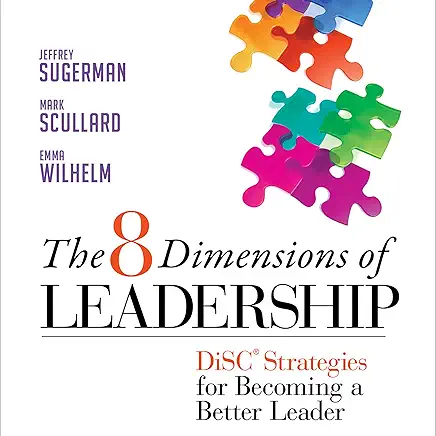“The 8 Dimensions of leadership” by Sugarman, Scullard, Wilhelm
Who is it for? for those looking to enhance their leadership skills
“The 8 Dimensions of Leadership” by Jeffrey Sugarman, Mark Scullard, and Emma Wilhelm is a comprehensive guide that aims to redefine leadership. The book presents a multi-faceted approach to leadership, proposing that there are eight distinct dimensions, each with its strengths and weaknesses. This model is designed to help current and aspiring leaders understand and develop their unique leadership styles.
The book’s primary strength lies in its detailed exploration of these eight dimensions – Pioneering, Energising, Affirming, Inclusive, Humble, Deliberative, Resolute, and Commanding. Each dimension is thoroughly dissected, offering insights into how leaders can harness their inherent qualities while also addressing potential pitfalls. The authors use the DiSC model (Dominance, Influence, Steadiness, and Conscientiousness) to categorize these leadership styles, providing a practical framework for readers to identify and cultivate their leadership abilities.
However, the challenge for readers, particularly those new to leadership roles or theories, is the complexity of integrating these dimensions into their leadership practice. The book requires readers to engage in deep self-reflection and honest self-assessment, which can be daunting. Understanding and applying one’s primary leadership dimension while balancing the others to be a well-rounded leader is not a straightforward task. It demands ongoing effort, adaptability, and sometimes, stepping out of one’s comfort zone.
Additionally, implementing the book’s guidance in diverse team environments can be challenging. Leaders must not only understand their leadership style but also how to interact with team members who may respond better to different dimensions of leadership. This requires a high level of emotional intelligence and interpersonal skills.
In conclusion, “The 8 Dimensions of Leadership” is an insightful and valuable resource for anyone looking to enhance their leadership skills. It offers a nuanced view of leadership, encouraging leaders to embrace their strengths while recognizing areas for improvement. The real challenge lies in the practical application of these concepts, requiring continuous self-improvement and the ability to adapt to the needs of different team members. For those willing to undertake this journey, the book is an excellent tool for developing a more effective and versatile leadership style.

